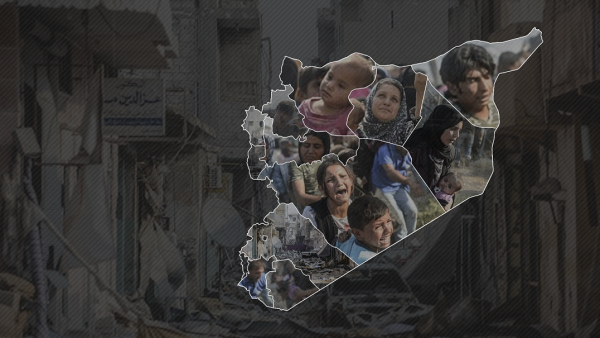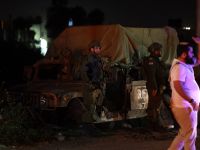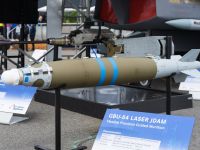- The Syrian 'de-escalation' zones were sold as a way to reduce violence and facilitate
- But violence has persisted and aid to Eastern Ghouta near Damascus is dangerously restricted
- Meanwhile, Turkey appears to be using the agreement as a way to heighten its fight against Kurds
- The de-escalation zones appear to have been advertised as a political solution but involve the continued victimization of the Syrian people to help cement Assad's rule
By Ty Joplin
A man stands in front of IRAM rocket launchers in eastern Damascus.
In eastern Damascus, a man stands proudly in front of a new truck armed with rockets. Painted in desert camouflage, the truck is part of the Syrian Arab Army’s (SAA) 4th Armored Division, and can lob devastating munitions vaguely at targets up to one and a half kilometers away.
The rockets will likely be aimed towards Syria’s Eastern Ghouta, a suburban region of Damascus with more than 350,000 inhabitants that has been under siege by Syrian troops backed by Russian airstrikes. Eastern Ghouta is, on paper, a designated ‘de-escalation’ zone where any military activity is kept to a minimum and aid flows unhindered.
On the ground, the reality is desperate. The idea that Eastern Ghouta is in a ‘de-escalation’ zone seems more politically concocted myth than reality.
Eastern Ghouta is enduring its worst period of violence since the de-escalation agreement was agreed upon in the summer.
In a time when the popular view on the Syrian Civil War is that it is winding down thanks to the imminent defeat of ISIS and the war’s key players agreeing to ‘de-escalate’ parts of Syria, residents of Eastern Ghouta are bracing themselves for the bombing to get worse.
Attempts at international mediation to bring an end to the war seem to have failed. Further attempts by countries other than Russia, Iran and Turkey, who are all directly intervening on behalf of their respective national interests, seems unlikely.
Even the eighth round of peace talks in Geneva underway now does not look promising to return a peace deal: Assad’s representatives refused to participate since leaders of the opposition still call for his removal as a part of achieving peace. Although they have changed their minds and will attend, they have little incentive to cede any ground to opposition factions, since Assad is now decisively winning the war.
As Assad and Russia block aid from coming into Eastern Ghouta and bomb schools, Turkey is entering into another de-escalation zone, Idlib, to supposedly enforce the agreement with observation posts.
Instead, Turkey appears to be using the de-escalation agreement as a gateway into Syria to exert pressure over the Kurdish-led Syrian Democratic Forces (SDF), who are deeply tied with the Kurdistan Worker’s Party (PKK), the Kurdish group warring with Turkey.
The same countries who championed themselves as negotiators and enforcers of the de-escalation agreement are also the ones with the most to gain by breaking it.
De-escalation may simply be a veil for Assad's ongoing, brutal military campaign to recapture the rest of Syria.
The De-Escalation Zones, Explained
Residents of Eastern Ghouta pull items and injured out of a bombed-out building, AFP/File
In a policy brief written to explain the concept of creating safe zones in the context of war, Geoff Gilbert, Professor of International Human Rights & Humanitarian Law at the University of Essex and Anna Magdalena Rüsch writes that safe zones, which can also be called de-escalation zones, “should be neutral, demilitarised and humanitarian in nature.” Professor Gilbert later clarified that “whether de-escalation zones could ever fulfil those criteria is questionable.”
They should also guarantee “access to humanitarian relief and assistance, and access by humanitarian organisations;”
Over the summer, Russia, Iran, Turkey and Syria met in Astana, the capital of Kazakhstan, and eventually agreed to establish four de-escalation zones in Syria. One in southern Syria, one in Eastern Ghouta near Damascus, another between Hama and Homs and the last in the Idlib Governorate in the north.
The full details of the agreement are not publically accessible, but a memo was circulated listing some of the agreement's’ major points: that Iran, Russia and Turkey would act as ‘guarantors’ to enforce the de-escalation zones, that Syria should remain unified, and the areas “shall be created with the aim to put a prompt end to violence, improve the humanitarian situation,” and work to end the war.
No other country signed on to enforce the de-escalation agreement or ensure they were actually created, and the United Nations was not involved.
- Renewed Clashes Reported in Syria’s Eastern Ghouta as De-Escalation Agreement Continues to Fail
- 227 Babies Have Died This Year in Syria's Eastern Ghouta
When asked about the treatment of civilians under the Astana agreements, Professor Gilbert explained that according to one Russian spokesperson, they were designed “to encourage the return of civilians.”
But the establishment of de-escalation, or safe zones, does not guarantee that these areas will indeed be safe: historically, they can actually endanger civilians.
According to Human Rights Watch, such zones allow large numbers of civilians to congregate in a single place, “making them a clear and exposed target to warring parties that may want to attack them.”
An infamous example of a ‘safe zone’ backfiring is the Serbian genocide of Bosnian Muslims at the town of Srebrenica in 1995. U.N. Protection Forces were unable or unwilling the prevent the town, which was designed a safe zone, from being captured by Bosnians Serbs, led by Ratko Mladić AKA the ‘Butcher of Bosnia.’
In total, over 8,000 civilians were massacred by Mladić’s men as they entered the town and executed escapees, the worst genocide in European history since the Holocaust. Mladić was convicted and sentenced to life in jail by a U.N. tribunal on Nov. 22 of this year, 12 years after the genocide.
Assad’s Escalating Besiegement of Eastern Ghouta
An airstrike hits inside of Arbin, in the Eastern Ghouta region near Damascus, Nov. 23 2017, Amer Almohibany/AFP
At the same time the Syrian government advertises for its efforts to streamline the flow of aid to conflict zones and stem violence via implementing de-escalation zones, it quietly lays siege to Eastern Ghouta, bombing it daily and choking off access to aid.
“Doctors in Eastern Ghouta share a sense of helplessness, loss of hope, and despair for not being able to provide the help for their patients – a feeling that is affecting them beyond what words can describe.” A doctor working in the besieged Eastern Ghouta told Maram Haddad, program assistant for Physicians for Human Rights.
Assad’s government forces, with the help of Russian airpower, has besieged several towns in Eastern Ghouta since 2013, constantly launching airstrikes and rockets into the territory and cutting off access to aid.
A new, sustained aerial campaign has killed over 100 and injured scores more since the start of November. On Nov. 10, U.N. experts demanded the Syrian government stop preventing aid from flowing into the Damascus suburbs and injured from leaving the zone to receive medical treatment.
شاهد | اللحظات الأولى بعد القصف الجوي على مدينة #عربين في #الغوطة_الشرقية والذي أسفر عن استشهاد مدني وإصابة آخرين pic.twitter.com/vBscD4sDrb
— HalabToday حلب اليوم (@HalabTodayTV) November 27, 2017
Civilians in Eastern Ghouta document the aftermath of airstrikes
According to Justin Clark, a journalist with Syria Direct, “last spring, the regime took the Barzeh, Tishreen and al-Qaboun neighborhoods northwest of East Ghouta and effectively shut down a system of tunnels that brought goods like food and fuel into the besieged enclave.”
A few months before the Syrian government agreed to establish Eastern Ghouta as a de-escalation zone, it cut off the biggest aid route into the region, the al-Wafideen crossing.
“The price of goods in East Ghouta has markedly raised, there is a shortage of medicine and food, and we're seeing an uptick in bombings,” Clark continues. Reports of child starvation and severe malnutrition are now a common element in assessing the desperate situation.
Denying aid to and besieging civilians Eastern Ghouta not only goes against the purpose of a de-escalation zone, it also violates international humanitarian law.
According to Clark, “it's not unlikely that the regime will pursue an Aleppo-style siege and combing campaign to take control of East Ghouta.” He also explains that the government may want to consolidate Damascus’ suburbs “in the east the same way it did in Western Ghouta.”
Maram Haddad calls the siege a “deliberate targeting of civilians through direct attacks on healthcare and livelihoods.”
Turkey is Turning its Back on Idlib
Turkish soldier movement during the Turkish army's Idlib operation near the Turkey-Syria border, Ilyas Akengin/AFP
Assad’s regime and Russia are not the only ‘guarantors’ turning their back on enforcing the de-escalation agreement.
Turkey appears to be using the terms of the deal, specifically the provision that allows for the establishment of observation posts throughout Idlib to police the deal, to heighten its position in its ongoing fight against armed Kurdish factions in the region.
Despite its rhetoric toward ensuring de-escalation in Syria, “when you look at official Turkish statements… it’s clear that one of Ankara's goals is to reign in Kurdish forces in the Afrin Canton.” Clark explains.
In mid-October, Turkish forces entered into Idlib and began building the observation posts. Though they are meant to survey all of Idlib within the de-escalation zone, attention was reportedly devoted to establishing a Turkish military presence in North and Northwest Idlib, just on the border between the Idlib Governorate and the Afrin Canton. The Afrin Canton is a mountainous region in northwest Syria controlled by Kurdish groups that Turkey believes to be terrorists.
“Turkey’s relations with Damascus may mean that the Assad government invited them in to act on their behalf in Idlib, like they have with Russia. If that is the case, Turkey and Syria are responsible for any breaches of international law that happened in Idlib,” Professor Gilbert notes.
Turkey has been one of the major backers of the anti-Assad Free Syrian Army (FSA), and has consistently supported regime change. However, as Assad cements his rule, Turkey may slowly be pivoting towards acquiescence--accepting Assad as a reality and working with him to unify Syria as any fragmented Syria would undoubtedly empower the Kurds.
- Geneva Peace Talks Might Start Before Arrival of Syrian Regime
- Report: Syrian Warplane Strikes Orphanage In Eastern Ghouta
“If Damascus did not ask them to do so, then unless Turkey feared an imminent attack that threatened its territorial integrity or political independence emanating from Idlib, Turkey has violated international law by using force in another sovereign state.”
It is unclear what Syria and Turkey have agreed to, but Turkey’s extra-territorial push towards Afrin,an area outside of the Idlib de-escalation zone, could very well constitute a violation of the Astana agreements.
Already, there have been reports of clashes between Turkish forces and the SDF, with civilian casualties reported. The SDF went so far as to accuse Turkey of “aggression and escalation.”
Regardless of whether Turkey has or has not violated the agreement, the people in Idlib’s ‘de-escalation zone’ continue to suffer from shelling, being caught between infighting within opposition factions, and ISIS attacks.
Where Does the World Leave Syria?
Sahar Dofdaa, AFP
The establishment of de-escalation zones was widely hoped to be the kind of international mediation Syria desperately needed. The zones were outwardly designed to reduce violence and help bring peace to the country which has been torn apart by war.
This does not appear to be happening.
International mediation has failed and perhaps pacified the international community, who perceive the Syrian war to be winding down, while it may simply be slowing into an even-more prolonged conflict. Neither the U.S. nor U.N. have shown a serious commitment to brokering or taking a lead in forging meaningful peace in the country.
Even worse, the powerful parties to the de-escalation agreement may be leveraging their role in enforcing the de-escalation zones to further their own political goals such as the capture of Eastern Ghouta or fighting the Kurds in Afrin.
What was thought to be the successful intervention of international actors to bring an end to the chaos of the war now looks to have been the eye of the storm--the calm in the middle of it all until the next wave hits.
With all this, a morbid idea comes into light: that the ‘de-escalation’ agreements were not made to reduce violence or help civilians or precipitate a peaceful end to the six-year war. With the way Assad, Turkey and Russia have manipulated them, the de-escalation agreements look to have been made to simply bolster their power and cement the Assad regime’s hold on Syria, freezing and fragmenting any counter-momentum.
So far, the international community has not responded to this concern, and has allowed Assad and his allies to continue its military campaign under the veil of de-escalation.
In understanding what that next phase of the Syrian civil war may look like, the death of Sahar Dofdaa may be a telling example.
On Sunday, Oct. 22, Sahar Dofdaa died of starvation in a hospital in Eastern Ghouta, where food and medical access is meant to flow unhindered.
At one month old, she died weighing less than two kilograms. The image of her crying shortly before she died haunted the world, but did not compel any new international pressure for Assad to end his siege, protect the trapped civilians, and begin complying with the de-escalation agreements.
One anonymous official pleaded, “The supplies are very low, and if it continues more kids will die.”







